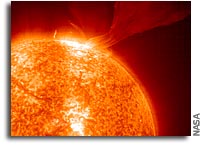NASA Strategic Roadmap: Sun – Solar System Connection

Full Document (PDF)
Executive Summary
NASA’s goal for future research and exploration within its Sun-Solar System Connection program is to observe and understand the complex phenomena associated with space weather by studying the Sun, the heliosphere and planetary environments as a single, inter-connected system. Such an understanding will represent not just a grand intellectual accomplishment for our times – it will also provide knowledge and predictive capabilities essential to future human and robotic exploration of space and will serve key societal objectives in important ways. Herein, we describe current plans for NASA’s research programs in this area and the guiding principles we will follow in pursuit of forthcoming exploration challenges.
The exotic environment of space beyond Earth’s protective atmospheric cocoon is highly variable and far from benign. Strongly influenced by the variability of the sun, a host of interconnected physical processes occur that affect the habitability of other space locales and the health and safety of travelers to those destinations. Building on NASA’s rich history of exploration of the Earth’s neighborhood and distant planetary systems, we will develop the quantitative knowledge needed to help assure the safety of the new generation of human and robotic explorers.
With focused research programs addressing specific space environmental hazards we will help guide the design and operations of safe and productive Exploration missions. At the same time we will pursue a deeper understanding of the fundamental physical processes that underlie the awesome phenomena of space.
This scientific exploration will target the highly coupled system that stretches from the sun’s interior to planetary neighborhoods and the vast expanses of interplanetary space. We are now transforming human understanding of this fascinating global system of systems, so closely connected that the same explosive event on the sun can produce power outages on the Earth, degradation of solar panels on interplanetary spacecraft, fatal damage to instrumentation in Mars orbit, and auroral displays at Saturn, effects that span the entire solar system. By expanding and deepening that understanding, we will not only develop a predictive capability to address hazards to space travelers and to important technological assets closer to home, but we will learn how the fundamental space processes interact to affect the habitability of other distant environments, beyond our own solar system.
Our near-term goals will be achieved by pursuing three groups of strategic missions.
The Solar-Terrestrial Probe missions will address fundamental science questions about the physics of space plasmas and the flow of mass and energy through the solar system. For example, Solar–B, a partnership mission led by Japan, will be launched in 2006 to observe how magnetic fields on the Sun’s surface interact with the Sun’s outer atmosphere, which extends millions of miles into space. The STEREO mission, also to be launched in 2006, will provide an unprecedented view of the threedimensional distribution of magnetic fields and particle flows throughout the heliosphere. And, the Magnetospheric Multiscale Mission, to be launched in 2011, will explore the fundamental physical processes responsible for the transfer of energy from solar wind to Earth’s magnetosphere and the explosive release of energy during solar flares.
The Living With a Star missions will enhance scientists’ knowledge of Earth–Sun system aspects that directly affect life and society. The Solar Dynamics Observatory, to be launched in 2008, will observe the solar interior and the Sun’s atmosphere continuously to determine the causes of solar variability. The Radiation Belt Storm Probes, to be launched in 2011, will determine how space plasmas are accelerated to hazardous energies, thereby enabling scientists to predict changes to planetary radiation environments and protect space explorers. The Ionospheric / Thermospheric Storm Probes, to be launched in 2015, will help scientists understand, to the point of acquiring a predictive capability, the effects of geomagnetic storms on the ionosphere / thermosphere–a region in the atmosphere located approximately 50 to 800 miles above Earth’s surface. Last, the Solar Sentinels, also to be launched in 2015, will provide understanding on the transition and evolution of eruptions and flares from the Sun to the planetary environments.
In the years ahead, portions of this spacecraft fleet will be configured into constellations – smart, strategically-located satellites that can work together to provide the timely, on-demand data and analysis to users who enable the practical benefits for scientific research, national policymaking, economic growth, hazard mitigation and the exploration of other planets in this solar system and beyond.
The interplay among observation, simulation, modeling and theory is viewed as essential for the vitality of our space science program. In some cases, a model or simulation will provide specific predictions to spur the course of future observation. In other cases, unexplained observations will lead to the development of new theories and the creation of entirely new models. As part of our explorationbased missions, we plan to continue supporting fundamental theory, modeling, data assimilation, and simulation programs, the development of space weather modeling frameworks, and the transition to applications-based codes necessary for space weather operational predictions. The burgeoning maturity of current, comprehensive theoretical modeling systems, spanning many regions and times scales, provides the essential underpinnings for NASA’s effort to integrate and synthesize knowledge of the complete system of systems.
Lastly, as an essential element of its plan to meet these challenging requirements, NASA will invite active participation by international and national partners to support the exploration and research program. It will also build and deploy exciting educational tools that will inspire and educate new generations of students and the American public. These partnerships, technologies, and educational materials will support and advance the space programs of all nations.








